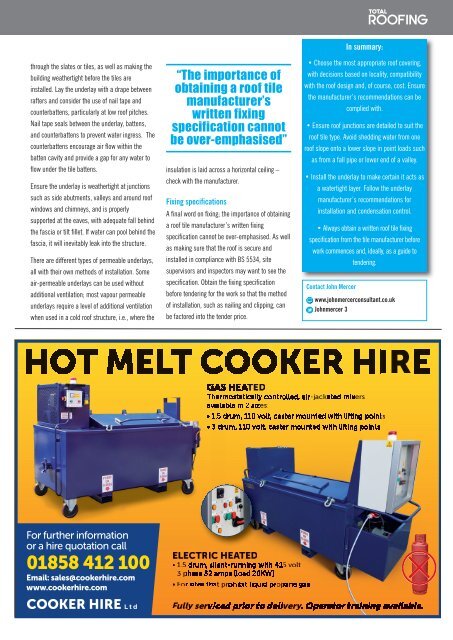December 2022
You also want an ePaper? Increase the reach of your titles
YUMPU automatically turns print PDFs into web optimized ePapers that Google loves.
through the slates or tiles, as well as making the<br />
building weathertight before the tiles are<br />
installed. Lay the underlay with a drape between<br />
rafters and consider the use of nail tape and<br />
counterbattens, particularly at low roof pitches.<br />
Nail tape seals between the underlay, battens,<br />
and counterbattens to prevent water ingress. The<br />
counterbattens encourage air flow within the<br />
batten cavity and provide a gap for any water to<br />
flow under the tile battens.<br />
Ensure the underlay is weathertight at junctions<br />
such as side abutments, valleys and around roof<br />
windows and chimneys, and is properly<br />
supported at the eaves, with adequate fall behind<br />
the fascia or tilt fillet. If water can pool behind the<br />
fascia, it will inevitably leak into the structure.<br />
There are different types of permeable underlays,<br />
all with their own methods of installation. Some<br />
air-permeable underlays can be used without<br />
additional ventilation; most vapour permeable<br />
underlays require a level of additional ventilation<br />
when used in a cold roof structure, i.e., where the<br />
“The importance of<br />
obtaining a roof tile<br />
manufacturer’s<br />
written fixing<br />
specification cannot<br />
be over-emphasised”<br />
insulation is laid across a horizontal ceiling –<br />
check with the manufacturer.<br />
Fixing specifications<br />
A final word on fixing; the importance of obtaining<br />
a roof tile manufacturer’s written fixing<br />
specification cannot be over-emphasised. As well<br />
as making sure that the roof is secure and<br />
installed in compliance with BS 5534, site<br />
supervisors and inspectors may want to see the<br />
specification. Obtain the fixing specification<br />
before tendering for the work so that the method<br />
of installation, such as nailing and clipping, can<br />
be factored into the tender price.<br />
In summary:<br />
• Choose the most appropriate roof covering,<br />
with decisions based on locality, compatibility<br />
with the roof design and, of course, cost. Ensure<br />
the manufacturer’s recommendations can be<br />
complied with.<br />
• Ensure roof junctions are detailed to suit the<br />
roof tile type. Avoid shedding water from one<br />
roof slope onto a lower slope in point loads such<br />
as from a fall pipe or lower end of a valley.<br />
• Install the underlay to make certain it acts as<br />
a watertight layer. Follow the underlay<br />
manufacturer’s recommendations for<br />
installation and condensation control.<br />
• Always obtain a written roof tile fixing<br />
specification from the tile manufacturer before<br />
work commences and, ideally, as a guide to<br />
tendering.<br />
Contact John Mercer<br />
www.johnmercerconsultant.co.uk<br />
Johnmercer 3<br />
For further r<br />
inform<br />
ation<br />
or a hire quotation call<br />
01858 412 100<br />
Email: sales@cookerhire.com<br />
www.cookerhire.com

















